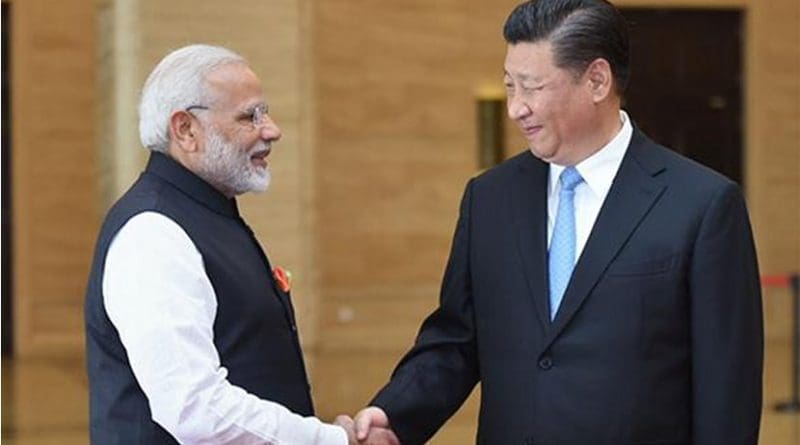Raising China-India Relations To A New Height – OpEd
By Zhiqun Zhu*
Relations between China and India –two emerging great powers—will undoubtedly shape the future of our world. The multi-dimensional bilateral relationship has been complex, sometimes difficult, in recent history. The 70-plus day tense standoff in Doklam/Donglang in Summer 2017 brought the two sides dangerously close to the first large-scale military clash since the 1962 border war.
Fortunately, cooler heads prevailed on both sides and the high tension was defused.
The Doklam/Donglang incident served as a wake-up call for both sides: distrust still runs deep in the relationship and they must work hard to manage the relations prudently. The incident also made the two countries realize once again the importance of cooperation and the risks of confrontation.
2018 will be remembered as a year when the two governments worked conscientiously to open a new chapter in bilateral relations.
The “informal” meeting between Indian Prime Minister Narendra Modi and Chinese President Xi Jinping in Wuhan, China in April is significant in the history of the relationship. It does not matter which side initiated the Wuhan meeting; the fact the two leaders had a candid, thorough, and respectful dialogue alone is worth commending. During the meeting the two sides reportedly identified over 100 areas—both new and old–for potential cooperation. The two leaders also pushed for closer economic ties, with the target of raising bilateral trade to US$100 billion by 2020. Shortly after the Wuhan meeting, Xi and Modi met again in June and July during the Shanghai Cooperation Organization (SCO) Qingdao Summit and the BRICS Summit in Johannesburg, South Africa respectively, with both leaders reiterating the theme of close cooperation. Notably Chinese defense minister Wei Fenghe visited India in late August to enhance military interactions.
However, the picture is not so rosy. In addition to long-standing territorial disputes, India-China relations face serious challenges, particularly in strategic and economic spheres.
Strategically, India views China’s rise with concerns while China worries about India’s siding with the United States in the latter’s effort to counter China’s rise.
For example, India considers the China-Pakistan Economic Corridor (CPEC) a violation of its sovereignty since the CPEC passes through the controversial Kashmir region, which India claims to be its territory. India is also deeply concerned about Chinese investment in smaller South Asian countries, which India fears China is using to encircle India. China has invested in many infrastructure projects in South Asia, such as the Hambantota Port in Sri Lanka, which India fears China may use for military and intelligence-collecting purposes. With China’s growing clout in South Asia, India feels uncomfortable and fears losing its traditional sphere of influence. In implementing the Belt and Road Initiative, China needs to be more sensitive to concerns by countries along the routes.
Nevertheless, officially India does not consider China’s rise as a threat. For example, India has been lukewarm to the much-touted term “Indo-Pacific” that is increasingly being used by the United States to replace the traditional “Asia-Pacific”. A reason America changed the geographical term as well as its military command in Asia from Pacific Command (USPACOM) to Indo-Pacific Command (USINDOPACOM) is to highlight India’s potential role in America’s effort to counter China’s growing power and influence. However, India, following the traditional non-alignment spirit, has kept some distance from the Quadra-lateral group of the United States, Japan, Australia, and India. Both India and China maintain independent foreign policies and promote a multipolar system in which all nations live peacefully.
Economically, though there is a huge potential for close cooperation, right now India has a considerable trade deficit with China. In 2017 China-India trade hit US$84.44, and India’s trade deficit with China reached US$52. If not fixed, the trade imbalance will become a thorny issue in the bilateral relationship. The good news is China has promised to buy more from India, including rice, sugar, and pharmaceutical products and services.
To raise the relationship to a new height, both sides must also overcome another imbalance in the relationship. Presently the relationship is a little skewed with India fixated on China while China is not paying sufficient attention to India.
According to a recent study by the Inter-American Dialogue, a Washington, DC-based think tank, China now boasts nearly 60 research centers on the Latin American region. China probably has more such centers focused on the United States or Japan. It is unclear how many South Asia studies centers China has, let alone India studies centers, but Chinese scholars estimate the number of South Asia/India focused centers in China is much smaller.
While many India’s China scholars are fluent in Chinese, very few Chinese scholars understand Hindi or other non-English Indian languages. On the other hand, China has hosted thousands of Indian scholars in recent years, but few Chinese scholars have been invited to visit India.
Frequent meetings between Xi and Modi in 2018 have mapped out a promising future for the India-China relationship. The real challenge now is to turn that vision into reality.
*Zhiqun Zhu, PhD, is Professor of Political Science and International Relations at Bucknell University, USA.

